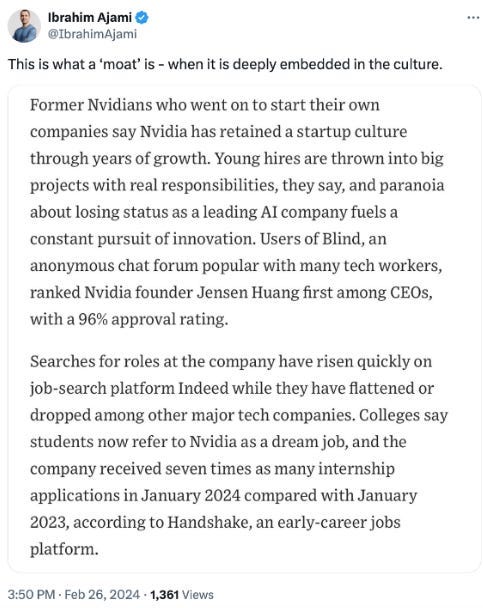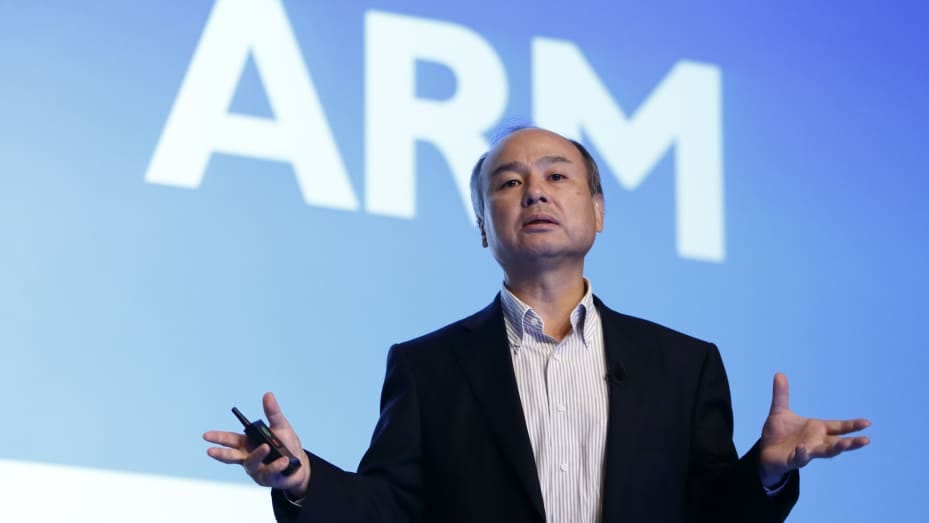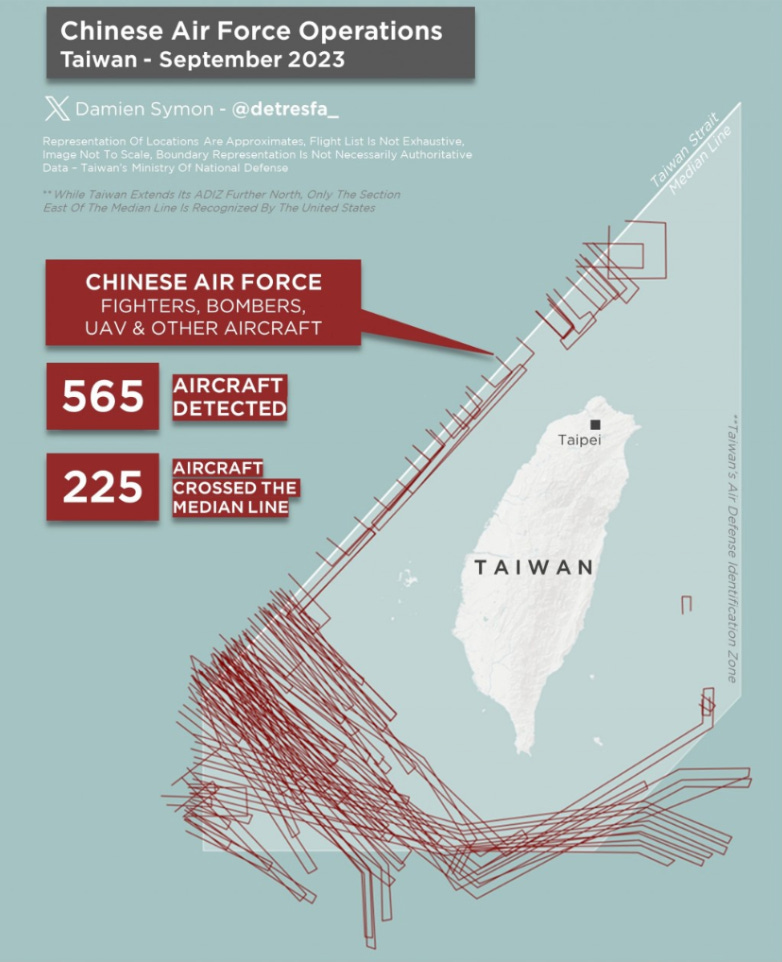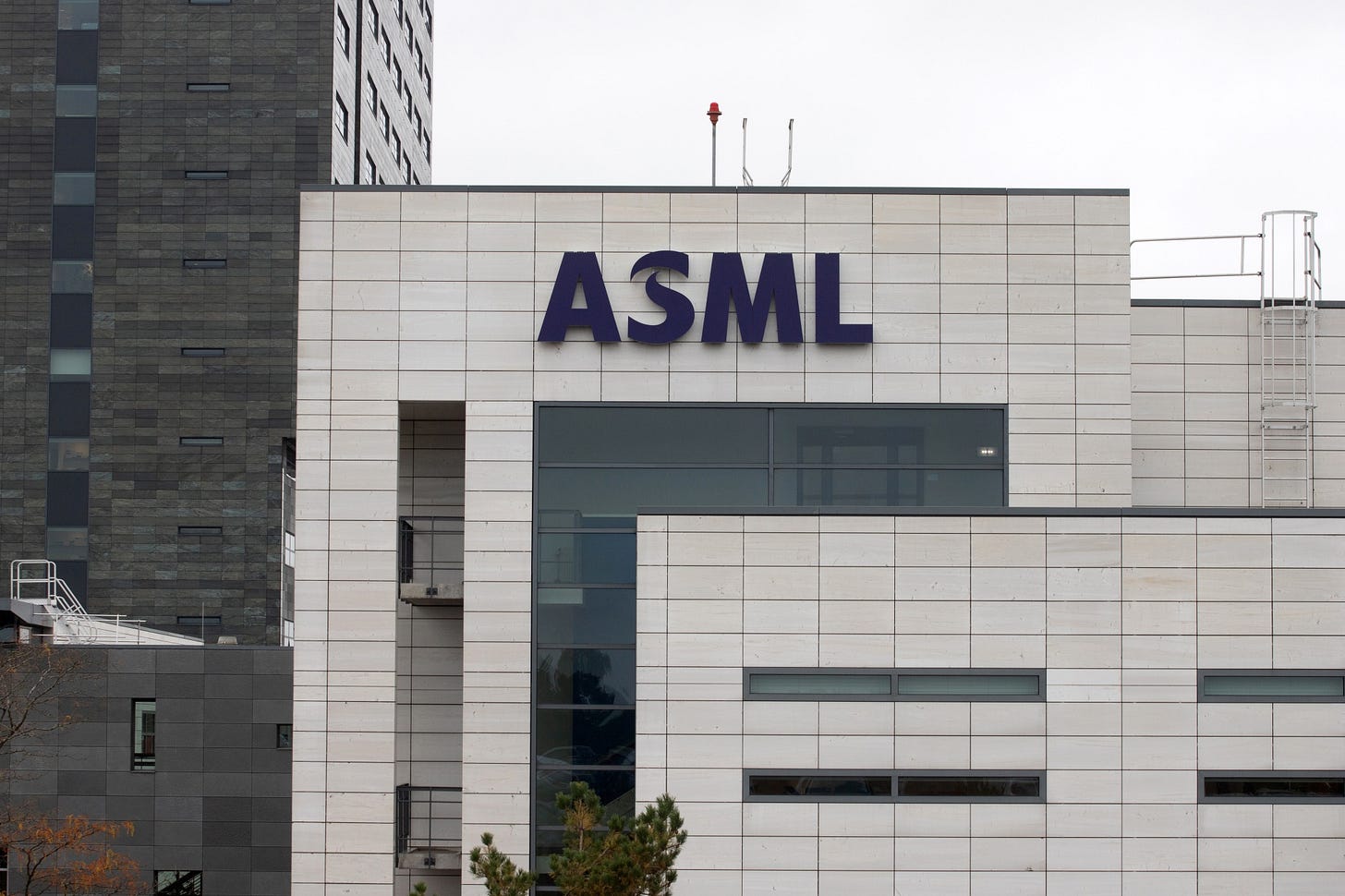GSV’s weekly insights on the global growth economy. Join our community of entrepreneurs, investors, executives, educators, and students getting a window to the future by subscribing here:
“The chip rush is bigger than any gold rush that has ever existed.” – Elon Musk
“For fun, our firm has an internal game of what public companies we’d invest in if we were a hedge fund. We’d put all our money into Nvidia.” – Marc Andreessen, 2016
“I would say that hardware is the bone of the head, the skull. The semi-conductor is the brain within the head. Software is the wisdom. And data is the knowledge.” – Masa Son
“Here’s a life tip: if someone called Masayoshi Son comes knocking on your door offering to manage your money any time soon, don’t let him. In fact, call the police and ask them to escort him from the premises.” - The Information, May 2022
Fast forward to today. Masa – who you were supposed to call the cops on for offering to manage your money – currently holds a massive position in Arm, a Cambridge, UK-based semiconductor designer. He bought Arm for $32 billion in 2016, and it’s now worth $132 billion.
Some call Masa a Riverboat Gambler, recklessly throwing down chips on whatever is catching his fancy at the time. The record suggests that he has an uncanny ability to see the future way before the average mortal. And he’s willing to put his money where his mouth is.
Vinod Khosla has a quote on the good news about venture investing: “You only lose 1x your money if you fail, but if you succeed, you can make 100x.”
Masa sings from the same hymnal.

He was an early investor in Yahoo when everyone still thought it was a chocolate drink. His $20 million investment in Alibaba in 1999 before people knew how to spell Jack Ma’s name returned $72 billion over the next 23 years.
Venture Capital is a Power Law business. It only takes one winner and the conviction to hold onto it…and Masa has been stacking chips for a long time.
Whether it’s Arm, NVIDIA, or others, one thing is for certain: semiconductors are the foundational building blocks for AI computing…and the 21st century.
It Takes A Silicon Village
It’s 1777 in the AI Revolution. The question is, who is going to arm it?
First Draft Pick: NVIDIA
It’s a 31-year-old overnight success story. It was the best-performing stock in 2001, 2016, and 2023. Even with 30,000 employees, they operate with startup-like efficiency and dedication to innovation. CEO Jensen Huang is also known for his unique management style, with 50 direct reports.
This culture has yielded results, and the data suggest they should expect to continue winning the talent wars.

What the casual observer may not realize, though, is that Nvidia does not make chips. They design them. And they design them well. Their most recent data center GPU is 6x faster prior than their formerly ground-breaking release.
Across the Pacific, Taiwan Semiconductor Manufacturing Company (TSMC) manufactures 90% of Nvidia’s chips (and has a 90% market share in advanced semiconductors globally).
Nvidia has been beloved by gamers and crypto miners for a long time - because of its cutting-edge graphics processing units (GPUs) that offer exceptional performance, efficiency, and versatility for a wide range of applications. Crypto miners particularly favored NVIDIA due to the GPUs' computational power, which is crucial for mining Bitcoin and Ethereum, making them the preferred choice during crypto run-ups in the 2010s.
However, NVIDIA shifted its focus towards AI technologies all the way back in 2006, positioning itself as a leading AI company with applications in various industries. It was 18 years ago that NVIDIA released its Compute Unified Device Architecture (CUDA) platform, a major innovation in GPU-based parallel computing technology.
Nvidia was prepared, and when the AI Boom officially arrived with the release of ChatGPT on November 30, 2022, it pounced. Consider this mind-blowing statistic: Nvidia’s $47.5 billion in data center revenue this year is 18% more than total data center revenues for the past five years combined – Nvidia generated $40.2 billion in DC revenue between FY18 through FY23.
The expansion of Nvidia's Data Center revenue is the leading indicator for the AI Revolution…and all signs are pointing to the fact that the race is on.
China and Taiwan
90% of advanced chips are manufactured by TSMC on the island of Taiwan. TSMC counts giants like Qualcomm, Apple, AMD, Broadcom, and of course Nvidia, as clients. TSMC chips are used in vehicles, weapons systems, and medical devices.
Despite Taiwan being governed independently since 1949, China claims that the island nation is part of its territory.
You don’t have to be Henry Kissinger to understand why these are dicey circumstances. China’s increased assertiveness has been demonstrated in the form of incursions into Taiwan’s Air Defense Identification Zone (ADIZ). Bloomberg Economists estimate that a Taiwan war would cost roughly 10% of global GDP and catalyze a global depression.
While Hakuna Matata would be a more convenient philosophy, the reality is that most experts expect a Chinese-Taiwan confrontation at some point. The consequences of that are nothing short of catastrophic for the global economy.
As CJ Muse from Evercore puts it, “The biggest risk is US-China relations and the potential impact to TSMC. If I’m a shareholder in Nvidia, that’s the only thing that keeps me up at night.”
This article from the Council on Foreign Relations sees a conflict occurring anytime from this decade to 2049. We don’t have to rely on strategists; we can take Xi Jinping at his own word, who talks about the reunification of China and Taiwan no later than 2049…the Chinese Dream.
The Chinese Dream is the American Nightmare. While the USA was asleep for too long and in an unacceptably vulnerable position, it finally woke up appropriately scared.
CHIPS Act
America invented semiconductors.
30 years ago, 40% of chips were made in the US…today, less than 10% are made here.
Today, TSMC has a 90% share of high-end chips which makes Xi’s Sabre Rattling…rattling.
The United States passed the CHIPS Act in August 2022 to provide federal funds to assist the onshoring efforts associated with chip production. It’s proven especially timely given the AI Bonanza started just 4 months later…and has no end in sight.
The act provides $52 billion in upfront funding to accelerate the development of a domestic supply chain for semiconductors...and reduce the US’s reliance on international supply lines. The most important resource in the World is something that the US ultimately does not control and cannot manufacture within its own borders (as of now).
Semiconductor facilities are being built across the United States, but notably, they’re outside traditional technology hotspots such as Silicon Valley, New York City, and Boston. Texas, Ohio, Upstate New York, and Arizona are emerging as key hubs, with the help of federal funding.
These companies are all partnering with local universities to develop the human capital required to power the industries of the future. Netherlands-based ASML invested several hundred million euros to build a research institute with the Eindhoven University of Technology. The partnership will support 500 researchers and 40 new PhD students per year.
In the US, Phoenix in particular is becoming a “chip capital,” led by the innovative efforts of Arizona State University. ASU went “all in” on semiconductors as a future growth industry well before its peers, and has been rewarded accordingly.
An FT report found that of the $242 billion that has been invested in American chipmaking since 2003, more than $60 billion has been invested in Maricopa County since 2020. ASU is creating opportunities for its 30,000+ engineering students right in its backyard.
ASU’s efforts show the importance of human capital in being able to invent, innovate and design the chips to power the future.
To understand the dynamics that led to our precarious position we’re in, Exhibit 1 is the story of Morris Chang, the Founder of TSMC.
Morris Chang studied, lived, and worked in the US for 30 years, but realized that the future of advanced manufacturing appeared was going to be in Asia. Labor there was faster, cheaper, and better.
The massive opportunity for the CHIPS Act is twofold…. (1) recruiting the World’s All-Stars and bringing them to the United States (the next Jensen Huang and Morris Chang), and (2) training and retaining an entirely new category of middle-class manufacturing jobs in the US.
Notably, this does not include spending more time coding…as Jensen Huang just said that kids shouldn’t learn how to code. Instead, human capital can be freed up by AI to tackle these higher-order issues.
It’s been forecasted that over 1.4 million new semiconductor jobs could emerge in the US between now and 2030…and those projections were before the AI explosion.
This is a major opportunity for universities and others to address this huge demand imbalance.
One company to watch in this emerging industry is TAP aka Training All People (Disclosure: GSV Ventures investment). TAP was founded by Jason Spyres, a former Palantir engineer and Stanford CS student. Before that, Jason began his “career” selling cannabis, which he received a 15-year sentence for.
We need to turn prisons into prep schools, and bring other people who are underemployed with huge potential into an industry that will shape the way the World is going, and give them the skills they need to thrive.
TAP’s mission is to provide next-generation technician training for the semiconductor industry using immersive learning (including AR, VR, and XR). TAP’s coursework is dramatically more effective, engaging, and entertaining than your standard workforce development course. It feels as fun as Lego Star Wars while learning the ins and outs of how to operate at a fab.
TAP is a win-win for both employers and students. Employers get a pool of highly skilled technicians at a scale and speed that’s dramatically better than the industry standard…at a fraction of the cost. Students get the opportunity to pursue a middle-class lifestyle and the American Dream, in a rapidly growing and dynamic industry.
For all the talk about AI eliminating jobs, this innovation is creating a massive new industry…one that doesn’t require you to have a college degree or live in a major city. The semiconductor industry could be just as revolutionary for America’s middle-class workforce as Henry Ford’s assembly line.
Scientific advancements and human ingenuity in chips will power changes in healthcare, space, digital currency, education, transportation, and homes...the ability to go where no man’s gone before (literally and figuratively).
Microsoft Copilot’s Rendition of A Futuristic City Powered By Semiconductors…Looks A Lot Like Dubai 😉
Importantly, man and machine are required to power this next computing cycle. AI needs human ingenuity and knowledge to flourish as an industry…unlocking the potential of human capital will be more important than ever in the AI era.
Just like the Gold Rush, we’re not sure if those trillions will flow to the miners, the Levi Strauss’s of the World, or the real estate tycoons. But we are sure that there will be thousands of startups, millions of middle-class jobs, and legendary companies created in the process.
Giddy Up!
Appendix
Tale of the Tape: Semiconductor Valuation and R&D Investment
Semiconductor Value Chain

Long-Term Returns of Semiconductors
Note: The video clip featuring Anduril CEO Palmer Luckey and Founders Fund CMO Mike Solana is from a November interview on the Pirate Wires podcast.
Market Performance
Bolstered by solid earnings, stocks moved higher last week led by NASDAQ’s 1.7% gain.
The S&P 500 advanced .9% to a fresh all time high and was up 5% for February. The 30 Company Dow declined .9% for the week.
With 90% of the S&P 500 reporting, revenue was up 3.8% and earnings 7.5% giving confidence to the future outlook. GDP growth for the second half of 2023 was revised to 3.2% also fueling optimistic expectations for 2024.
Interestingly, the USA isn’t alone in investors confidence in equities. The German DAX, the French CAC and Japan’s NIKKEI all made new all time highs last week, with Japan finally the peak from 1989.
Confirming our thesis going into the year, we had predicted we’d see a broadening of participation in the Market which we are starting to see. While the “Magnificent 7” has been reduced to the “Magnificent 2” (NVIDIA and Meta) and the “Pretty Good 1” (Amazon), small cap stocks were up 5.5% in February. The GSV Model Portfolio is up 18% YTD and nearly 70% in the past 52 weeks.
Quietly, but tellingly, Bitcoin has been on fire up 20.8% last week and 41.4% YTD. We think signs point to a continued thawing in the overall Market, with Winter turning to Spring. We also believe that we will start to see a fresh batch of IPO’s by the time tulips start to blossom providing fresh oxygen for growth investors.
Maggie Moe’s GSV Weekly Rap
Need to Know
READ: Corporate Ozempic | No Mercy / No Malice
LISTEN: Ali Hamed - Building an Investment Firm
WATCH: Uncovering the Truth: Is China's Economy Collapsing? w/ Kyle Bass (TIP611)
READ: Clouded Judgement 2.29.24 - Shades of 2021 (h/t
)LISTEN: Justin Ishbia: The Three Traits Required to Succeed in Private Equity | E1119
WATCH: New AI Startup Paradigm: Copilots Aren't Good Enough! -Benchmark Capital GP Sarah Tavel
READ: Magnificent Ignorance about the Magnificent Seven
GSV’s Four I’s of Investor Sentiment
GSV tracks four primary indicators of investor sentiment: inflows and outflows of mutual funds and ETFs, IPO activity, interest rates, and inflation. Here’s how these four signals performed last week:
#1: Inflows and Outflows for Mutual Funds & ETFs
Source: X
#2: IPO Market
#3: Interest Rates
Source: Kobeissi Letter
#4: Inflation
Source: Charlie Bilello
Chart of the Week
Volatility is the Price for Long-Term Performance…since 1928, stocks have had the highest return and the highest volatility.
Chuckles of the Week
EIEIO…Fast Facts
Entrepreneurship: 55% – percent of Americans who work for an SMB (Jeff Richards)
Innovation: 31% – percent of 2023 US venture capital that went to companies in the Bay Area (Peter Walker)
Education: $38,000 – spending per K-12 student in NYC in 2024 (Chalkbeat)
Impact: 8 in 10 – Gen Z and millennials who expect to shape the future through their work (Engage for Good)
Opportunity: 6X – high achieving students from low-income families are 6 times less likely to enroll in highly selective universities compared to high-achieving students from high-income families (Inside Higher Ed)
FEEDBACK: We love it when our readers engage with us. Send your thoughts, comments, and feedback to dashmediagsv@gmail.com – we read every email!
Connecting the Dots & EIEIO…
Old MacDonald had a farm, EIEIO. New MacDonald has a Startup….EIEIO: Entrepreneurship, Innovation, Education, Impact and Opportunity. Accordingly, we focus on these key areas of the future.
One of the core goals of GSV is to connect the dots around EIEIO and provide perspective on where things are going and why. If you like this, please forward to your friends. Onward!
Make Your Dash Count!
-MM
































